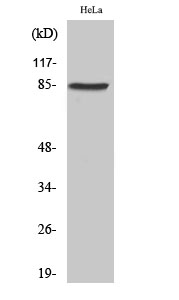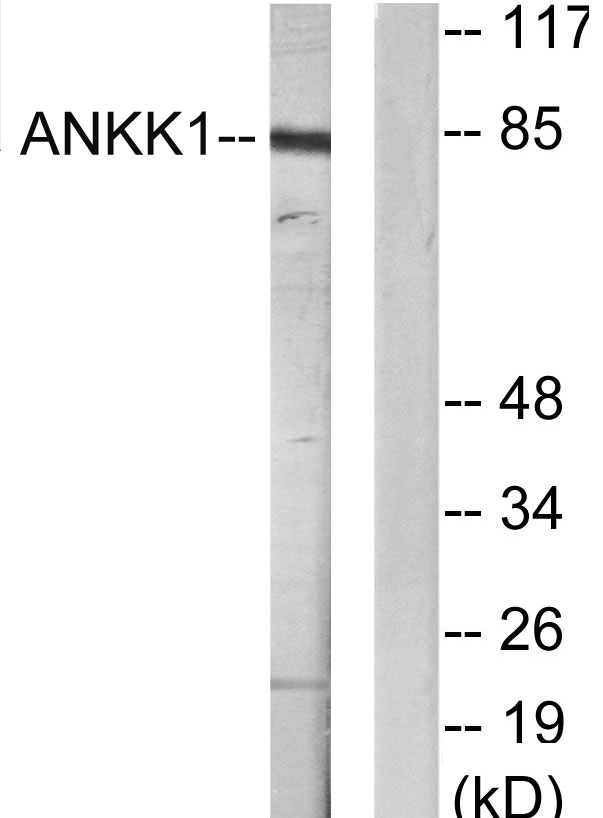SgK288 Polyclonal Antibody
- Catalog No.:YT4272
- Applications:WB;ELISA
- Reactivity:Human;Mouse
- Target:
- SgK288
- Gene Name:
- ANKK1
- Protein Name:
- Ankyrin repeat and protein kinase domain-containing protein 1
- Human Gene Id:
- 255239
- Human Swiss Prot No:
- Q8NFD2
- Mouse Swiss Prot No:
- Q8BZ25
- Immunogen:
- The antiserum was produced against synthesized peptide derived from human ANKK1. AA range:321-370
- Specificity:
- SgK288 Polyclonal Antibody detects endogenous levels of SgK288 protein.
- Formulation:
- Liquid in PBS containing 50% glycerol, 0.5% BSA and 0.02% sodium azide.
- Source:
- Polyclonal, Rabbit,IgG
- Dilution:
- WB 1:500 - 1:2000. ELISA: 1:20000. Not yet tested in other applications.
- Purification:
- The antibody was affinity-purified from rabbit antiserum by affinity-chromatography using epitope-specific immunogen.
- Concentration:
- 1 mg/ml
- Storage Stability:
- -15°C to -25°C/1 year(Do not lower than -25°C)
- Other Name:
- ANKK1;PKK2;SGK288;Ankyrin repeat and protein kinase domain-containing protein 1;Protein kinase PKK2;Sugen kinase 288;SgK288;X-kinase
- Observed Band(KD):
- 84kD
- Background:
- The protein encoded by this gene belongs to the Ser/Thr protein kinase family, and protein kinase superfamily involved in signal transduction pathways. This gene is closely linked to DRD2 gene (GeneID:1813) on chr 11, and a well studied restriction fragment length polymorphism (RFLP) designated TaqIA, was originally associated with the DRD2 gene, however, later was determined to be located in exon 8 of ANKK1 gene (PMIDs: 18621654, 15146457), where it causes a nonconservative amino acid substitution. It is not clear if this gene plays any role in neuropsychiatric disorders previously associated with Taq1A RFLP. [provided by RefSeq, Sep 2009],
- Function:
- catalytic activity:ATP + a protein = ADP + a phosphoprotein.,similarity:Belongs to the protein kinase superfamily. TKL Ser/Thr protein kinase family.,similarity:Contains 1 protein kinase domain.,similarity:Contains 12 ANK repeats.,tissue specificity:Highly expressed in brain and weakly expressed in placenta and spinal cord.,
- Expression:
- Highly expressed in brain and weakly expressed in placenta and spinal cord.
- June 19-2018
- WESTERN IMMUNOBLOTTING PROTOCOL
- June 19-2018
- IMMUNOHISTOCHEMISTRY-PARAFFIN PROTOCOL
- June 19-2018
- IMMUNOFLUORESCENCE PROTOCOL
- September 08-2020
- FLOW-CYTOMEYRT-PROTOCOL
- May 20-2022
- Cell-Based ELISA│解您多样本WB检测之困扰
- July 13-2018
- CELL-BASED-ELISA-PROTOCOL-FOR-ACETYL-PROTEIN
- July 13-2018
- CELL-BASED-ELISA-PROTOCOL-FOR-PHOSPHO-PROTEIN
- July 13-2018
- Antibody-FAQs
- Products Images

- Western Blot analysis of various cells using SgK288 Polyclonal Antibody

- Western blot analysis of lysates from HeLa cells, using ANKK1 Antibody. The lane on the right is blocked with the synthesized peptide.


